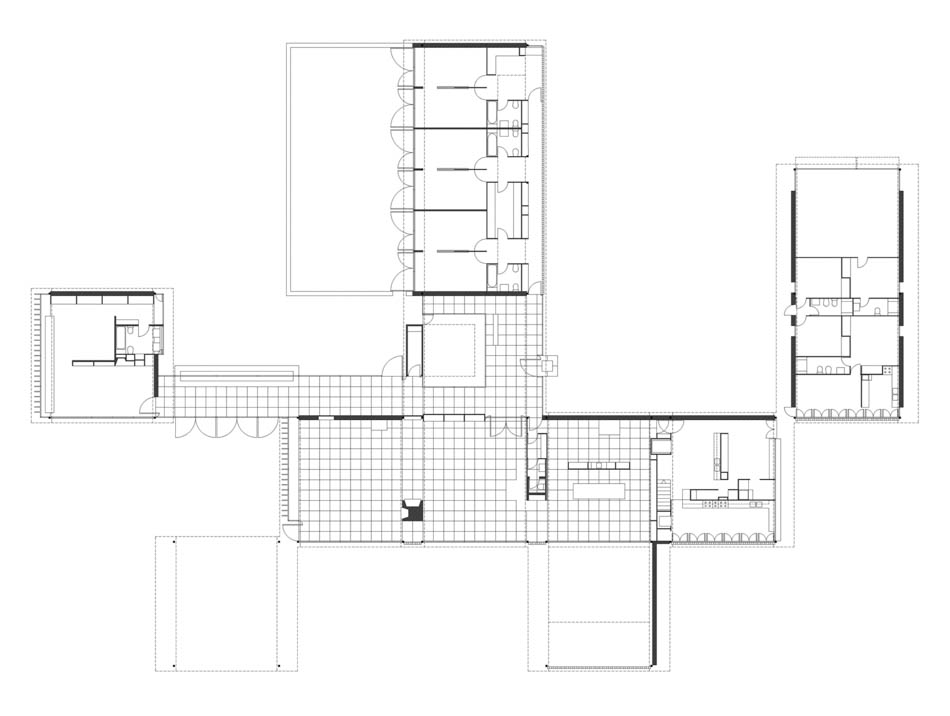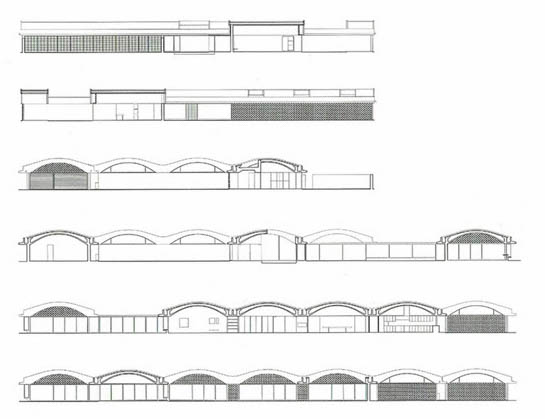El proyecto se beneficia de unas condiciones excepcionales de partida: un excelente lugar de ubicación, varias hectáreas de pinar a orillas del mar en el área de la laguna de la Ricarda, y una inmejorable disposición del cliente, culto y exigente, que pretende construirse una casa de veraneo y fin de semana a pocos kilómetros de Barcelona.

Foto aerea
Desde los primeros contactos entre arquitecto y promotor en 1949 hasta materializarse finalmente la obra transcurrieron 13 años. La segunda propuesta desarrollada por Bonet a partir de 1953 fue la finalmente aceptada y construida. El desarrollar la vivienda en una sola planta prescindiendo de las vistas sobre el mar será una renuncia productiva. Sobre el terreno natural, se acondiciona una plataforma de nivelación que recibe la casa y sus espacios exteriores próximos. La línea de fachada queda a 130 m de la arena de la playa y la cota máxima de altura de lo construido será de 3’75 m sobre el suelo modificado.
La casa se organiza a partir de la agregación de un módulo –estructural y espacial- de una planta de altura (8’80 x 10’10m). Dicho módulo está formado por una cubierta abovedada de 7’5 m de cuerda que alcanza una altura máxima de 3’10m rematada por dos aleros laterales planos -1’30 m a lado y lado-que recogen el empuje horizontal. La estructura vertical de cada módulo la constituyen cuatro pilares metálicos formados por 2 UPN de 0’13 m que quedan recibidos por el alero.

Maqueta
La agregación de módulos se produce en la dirección longitudinal prolongando una bóveda con la siguiente y en la dirección lateral con la mediación de los aleros. Esta unidad básica queda al descubierto en el módulo-porche adelantado a la sala de estar. Cuatro módulos concatenados por el alero forman los espacios comunes, centrales, de la casa –salón, comedor y cocina-. Respecto a esta banda se avanzan hacia el sur dos módulos abiertos que ganan espacio al jardín y crecen hacia el norte las alas de los dormitorios. La voluntad del arquitecto era mantener el módulo del dormitorio principal completamente independiente –tal como se ve en la foto de la maqueta- a lo que el cliente se resistió quedando finalmente unido al resto de la casa por un paso totalmente acristalado.
La trama geométrica pauta toda la plataforma exterior de nivelación de la casa. El tema de la unión del dormitorio principal al resto de la casa no es sólo funcional desvela un problema estrictamente arquitectónico: la dificultad de generar un paso lineal transversal a las bóvedas, tal como se ha planteado la unidad básica. La bóveda es el elemento estrella pero el alero es la clave de la articulación de los módulos hasta tal punto que los recortes que sufre la cubierta no afectan en ningún caso al alero del que se vigila celosamente su continuidad. El alero permite la concatenación de bóvedas lateralmente; recibe y conduce las aguas de la cubierta; su ancho delimita las zonas de circulación –del acceso a las habitaciones, de la escalera al sótano, del paso exterior entre la cocina y el garaje-; también articula las conexiones de paso entre estancias; alberga servicios de apoyo como el vestidor, el aseo de cortesía o la importante pieza de chimenea en el gran salón. La profundidad de 1’30 es la referencia para situar los cerramientos en las fachadas a este y oeste que van siempre en el borde exterior del alero o en el interior o a la mitad. Múltiples leyes internas se van derivando de la trama básica. Se superponen y entrelazan criterios para practicar las aberturas al exterior, iluminar, proteger de la insolación según la orientación; para revestir las superficies verticales y horizontales, para interponer las divisiones interiores o el mobiliario fijo, etc. Arquitecto y cliente mantuvieron una muy estrecha colaboración lo que posibilitó una labor de extrema delicadeza en la resolución de todos los pormenores de la vivienda que sorprende y cautiva al que visita la casa.
Los responsables de la restauración desde 1993, Fernando Álvarez y Jordi Roig, han hecho una restitución gráfica exhaustiva de la casa, labor que ha sido documentada y publicada, y que proporciona un inmejorable acercamiento a las condiciones técnicas del proyecto.
To begin with, the project benefited from an exceptional set of circumstances: an excellent location, various hectares of pinewood by the edge of the sea in the Ricarda lagoon area, and the unbeatable attitude of the client, cultured and exacting, who wanted to have a summer and weekend house built within a few kilometres of Barcelona. From the first contact between architect and developer in 1949 until the building finally materialized, thirteen years went by. The second proposal put together by Bonet in 1953 was the one that was finally accepted and built. Developing the house on a single floor and foregoing views of the sea was to prove productive as a form of renunciation. On the natural terrain a levelling platform was prepared that accommodates the house and its adjacent outside spaces. The line of the facade remains at 130 m from the sand beach and the maximum height of the building is 3.75 m above the modified ground surface.
The house is organized from the aggregation of a module—both structural and spatial—one storey in height (8.80 x 10.10 m). This module consists of a 7.50 metre-long vaulted roof that reaches a maximum height of 3.10 m, ending in two flat lateral overhangs, each one 1.30 m wide, that subsume the horizontal thrust. The vertical structure of each module consists of four metal pillars, consisting of two 0.13 m American standard channel profiles that are received by the over- hangs. The aggregation of modules is produced longways by prolonging one vault with the next, and sideways through the intercession of the overhangs. This basic unit is exposed in the porch-module jutting out from the living room. Four modules concatenated by the overhang form the house’s communal central spaces—lounge, dining room and kitchen. With regard to this strip, advancing southwards are two open modules that gain space from the garden and let the bedroom wings grow towards the north. The architect’s wish was to keep the master-bedroom module completely independent—as can be seen in the photo of the model—which the client resisted, so that finally the module was linked to the rest of the house by a totally glazed passageway. The geometrical grid regu- lates the entire external levelling platform of the house.
The issue of linking the master bedroom to the rest of the house is not only a functional one—it reveals a strictly architectonic problem: the difficulty of genera- ting a linear passageway sideways on to the vaults, as the basic unit had propo- sed. The vault is the star feature but the overhang is the key to the articulation of the modules, to such an extent that the setbacks the roof undergoes never affect the overhang, the continuity of which is jealously guarded. The overhang permits the sideways concatenation of vaults; it receives and evacuates rainwater from the roof; its width delimits the circulation areas—access to the bedrooms, the stairway to the basement, the outside passageway between kitchen and garage. It also articulates the connections of the passageway between rooms; accommo- dates backup services like the dressing room, the guest toilet and the imposing chimneybreast in the big lounge. Its 1.30 m depth provides the point of reference for situating the walling on the facades to east and west, which always extend on the outside edge of the overhang, or on the inside of it and halfway across. Many internal laws are derived from the basic grid. Superimposed and commin- gled are criteria for making the openings onto the outside, illuminating the house, protecting it from the sun according to its orientation; for facing the vertical and horizontal surfaces, for inserting the interior divisions or the fixed furniture, and so on. Architect and client worked closely together, which facilitated the extre- mely delicate task of resolving all the details of the house, which surprises and delights all who visit it.
The architects responsible for the restoration in 1993, Fernando Álvarez and Jordi Roig, made an exhaustive graphic reconstruction of the house, a work that has been documented and published, and which provides an unsurpassable approximation to the technical conditions of the design.
Fuente texto: Departamento de Proyectos de ETSAB / UPC
PLANOS

Planta (Fuente: Revista Tectónica)

Alzados

Axonometría del conjunto (Fuente: Revista Tectónica)

Despiece constructivo de un módulo tipo (Fuente: Revista Tectónica)

Detalle constructivo bóveda (Fuente: Revista Tectónica)

Modulación de la estructura (Fuente: Revista Tectónica)

Justificación geométrica de la concatenación de dos bóvedas (Fuente: Revista Tectónica)
CESIÓN DE DERECHOS
Si está interesado en utilizar alguna fotografía del reportaje para alguna publicación, revista, catálogo, etc, debe adquirir los derechos de reproducción correspondientes, dirigiéndose a cesión de derechos y rellenar el formulario.


































































1 comentario